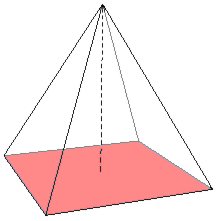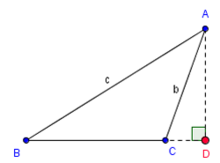Base (geometry)

In
.The side or point opposite the base is often called the apex or summit of the shape.
Of a triangle

In a triangle, any arbitrary side can be considered the base. The two endpoints of the base are called base vertices and the corresponding angles are called base angles. The third vertex opposite the base is called the apex.
The extended base of a triangle (a particular case of an
the extended base outside of the triangle.The area of a triangle is its half of the product of the base times the height (length of the altitude). For a triangle with opposite sides if the three altitudes of the triangle are called the area is:
Given a fixed base side and a fixed area for a triangle, the
Of a trapezoid or parallelogram
Any of the sides of a parallelogram, or either (but typically the longer) of the parallel sides of a trapezoid can be considered its base. Sometimes the parallel opposite side is also called a base, or sometimes it is called a top, apex, or summit. The other two edges can be called the sides.
Role in area and volume calculation
Bases are commonly used (together with heights) to calculate the areas and volumes of figures. In speaking about these processes, the measure (length or area) of a figure's base is often referred to as its "base."
By this usage, the area of a parallelogram or the volume of a prism or cylinder can be calculated by multiplying its "base" by its height; likewise, the areas of triangles and the volumes of cones and pyramids are fractions of the products of their bases and heights. Some figures have two parallel bases (such as trapezoids and frustums), both of which are used to calculate the extent of the figures.[2]
References
- ^ Palmer, C.I.; Taylor, D.P. (1918). Plane Geometry. Scott, Foresman & Co. pp. 38, 315, 353.
- ISBN 978-0-7167-4361-3.




